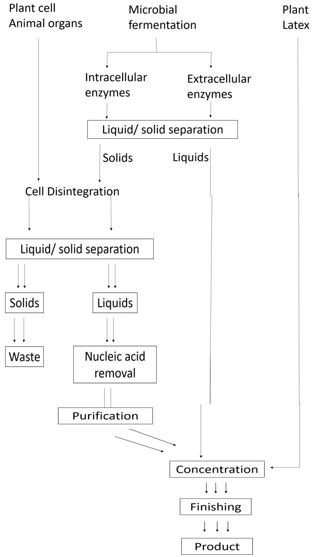This set of Enzyme Technology Multiple Choice Questions & Answers (MCQs) focuses on “Preparation of Enzymes from Clarified Solution”.
1. Some commercial enzyme preparations consist essentially of concentrated fermentation broth and additives.
a) True
b) False
View Answer
Explanation: Enzyme can be purified several hundred folds, but the yield may be poor. Whereas, industrial enzymes may be purified a little with minor material allowed to interfere which can be removed later. This will avoid the extra cost involved which is required to get a pure enzyme. Thus, some commercial enzyme preparations consist essentially of concentrated fermentation broth and additives. Hence the above statement is true.
2. Which of the following doesn’t cause enzyme inactivation?
a) Heat
b) Proteolysis
c) Centrifugation
d) Sub-optimal pH
View Answer
Explanation: Centrifugation separates on the basis of the particle size and density difference between the liquid and solid phases. It doesn’t cause enzyme inactivation. Enzyme inactivation is caused by the following processes: Heat, proteolysis, sub-optimal pH, oxidation, denaturants, irreversible inhibitors and loss of cofactors or coenzymes.
3. Which of the following doesn’t cause enzyme inactivation?
a) Oxidation
b) Denaturants
c) Filtration
d) Irreversible inhibitors
View Answer
Explanation: Filtration separates simply on the basis of particle size and does not cause enzyme inactivation. Oxidation, denaturants, irreversible inhibitors, heat, proteolysis, sub-optimal pH, loss of cofactors or coenzymes etc., causes enzyme inactivation.
4. ___________ is also the major reason for enzyme inactivation by microbial contamination.
a) Proteolysis
b) Heat
c) Loss of co-factors or co-enzymes
d) Oxidation
View Answer
Explanation: Proteolysis is the main reason for enzyme inactivation by microbial contamination. It may occur if proteases are present in the living cell. When the enzymes are in their native form, they are resistant to attack by proteases because of highly structured domains which lower the bonds available for protease attack. Protease may produce single nicks that have little effect of protein conformation and hence the activity.
5. Which of the following causes of enzyme inactivation?
a) Filtration
b) Loss of cofactor or coenzymes
c) Centrifugation
d) Crossflow microfiltration
View Answer
Explanation: Loss of cofactors or coenzymes causes enzyme inactivation. The following processes doesn’t cause enzyme inactivation:
• Filtration separates simply on the basis of particle size.
• Centrifugation separates on the basis of the particle size and density difference between the liquid and solid phases.
• Crossflow microfiltration is a process in which high tangential flow of the feedstock across the surface of the filter is used.
6. What is represented in the following diagram?

a) Insulin production
b) Protein generation cycle
c) Preparation of enzymes
d) Site directed mutagenesis
View Answer
Explanation: In the diagram above, a flowchart of the preparation of enzymes is shown. Most of the commercial enzymes are produced extracellularly by microbe, plants or animal cells into the cell further processed. Once the cells enzymes are in solution along with other materials, solid liquid separation may be performed. This helps to remove cell debris or unwanted cells. Further, the precipitate is collected by filtration, centrifugation or aqueous biphasic partition. Once the enzyme is purified, the product concentrated and final finishing is done to produce the enzyme.
Sanfoundry Global Education & Learning Series – Enzyme Technology.
To practice all areas of Enzyme Technology, here is complete set of 1000+ Multiple Choice Questions and Answers.
If you find a mistake in question / option / answer, kindly take a screenshot and email to [email protected]
- Practice Biotechnology MCQs
- Practice Chemical Engineering MCQs
- Apply for Chemical Engineering Internship
- Check Chemical Engineering Books
- Apply for Biotechnology Internship
